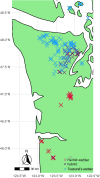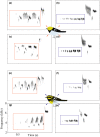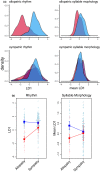Processes underlying complex patterns of song trait evolution in a Setophaga hybrid zone
- PMID: 34188811
- PMCID: PMC8216987
- DOI: 10.1002/ece3.7559
Processes underlying complex patterns of song trait evolution in a Setophaga hybrid zone
Abstract
During secondary contact between two species when hybrids are less fit than parents, mating signals are expected to diverge, while aggressive signals are expected to converge. If a single signal trait is used in both mating and aggression, then the dynamics between these two forces could influence the evolutionary trajectory of that trait. We studied such a situation in an avian hybrid zone between two Setophaga species, where birdsong is used in both mate attraction and territory defense. We hypothesized that song modules of the two species will show separate and distinct geographic patterns due to the influence of selective pressures for effective territorial aggression and for effective mate attraction. We conducted geographic cline analyses and playback experiments across this hybrid zone. We found an unexpected geographic pattern of asymmetric introgression of song rhythm, which may be explained by results of the playback experiments that suggest that differences in song rhythm serve a greater role in mate attraction than in territory defense. In contrast, differences in syllable morphology show little evidence of importance in mate attraction or territorial defense. Song features converge in the hybrid zone, yet patterns of trait change suggest that the song production modules may vary in their modes of development and inheritance. Syringeal motor gesturing, which gives rise to syllable morphology, shows a nonclinal mosaic pattern, suggesting that this trait may be predominantly learned. In contrast, respiratory patterning, which forms song rhythm, shows a clinal geographic transition, suggesting that this trait could be more innate. The results indicate that opposing forces act independently on song via distinct modules of the song production mechanism, driving complex patterns of song trait evolution.
Keywords: aggression; birdsong; mating signals; reinforcement; vocal learning.
© 2021 The Authors. Ecology and Evolution published by John Wiley & Sons Ltd.
Conflict of interest statement
None declared.
Figures





Similar articles
-
Sharp acoustic boundaries across an altitudinal avian hybrid zone despite asymmetric introgression.J Evol Biol. 2016 Jul;29(7):1356-67. doi: 10.1111/jeb.12876. Epub 2016 Apr 23. J Evol Biol. 2016. PMID: 27037611
-
Mating signal variation and bimodality in a mosaic hybrid zone between Chorthippus grasshopper species.Evolution. 2002 Jun;56(6):1184-98. doi: 10.1111/j.0014-3820.2002.tb01431.x. Evolution. 2002. PMID: 12144019
-
Responses of Hermit Thrush (Catharus guttatus) males to conspecific playback with typical and atypical syntactical patterns.Behav Processes. 2022 Nov;203:104764. doi: 10.1016/j.beproc.2022.104764. Epub 2022 Oct 13. Behav Processes. 2022. PMID: 36243379
-
Mechanisms of Cultural Evolution in the Songs of Wild Bird Populations.Front Psychol. 2021 Apr 26;12:643343. doi: 10.3389/fpsyg.2021.643343. eCollection 2021. Front Psychol. 2021. PMID: 33981272 Free PMC article. Review.
-
Producing song: the vocal apparatus.Ann N Y Acad Sci. 2004 Jun;1016:109-29. doi: 10.1196/annals.1298.041. Ann N Y Acad Sci. 2004. PMID: 15313772 Review.
Cited by
-
The role of learned song in the evolution and speciation of Eastern and Spotted towhees.PLoS Comput Biol. 2025 Jun 17;21(6):e1013135. doi: 10.1371/journal.pcbi.1013135. eCollection 2025 Jun. PLoS Comput Biol. 2025. PMID: 40526780 Free PMC article.
-
Multi-character approach reveals a new mangrove population of the Yellow Warbler complex, Setophaga petechia, on Cozumel Island, Mexico.PLoS One. 2023 Jun 22;18(6):e0287425. doi: 10.1371/journal.pone.0287425. eCollection 2023. PLoS One. 2023. PMID: 37347741 Free PMC article.
-
Limited Song Mixing Without Genomic Gene Flow in a Contact Zone Between Two Songbird Species.Mol Biol Evol. 2023 Mar 4;40(3):msad053. doi: 10.1093/molbev/msad053. Mol Biol Evol. 2023. PMID: 36869752 Free PMC article.
References
-
- Baptista, L. F. , & Trail, P. W. (1992). The role of song in the evolution of passerine diversity. Systematic Biology, 41, 242–247. 10.1093/sysbio/41.2.242 - DOI
-
- Barton, N. H. , & Hewitt, G. M. (1985). Analysis of hybrid zones. Annual Review of Ecology and Systematics, 16, 113–148. 10.1146/annurev.es.16.110185.000553 - DOI
Associated data
LinkOut - more resources
Full Text Sources

